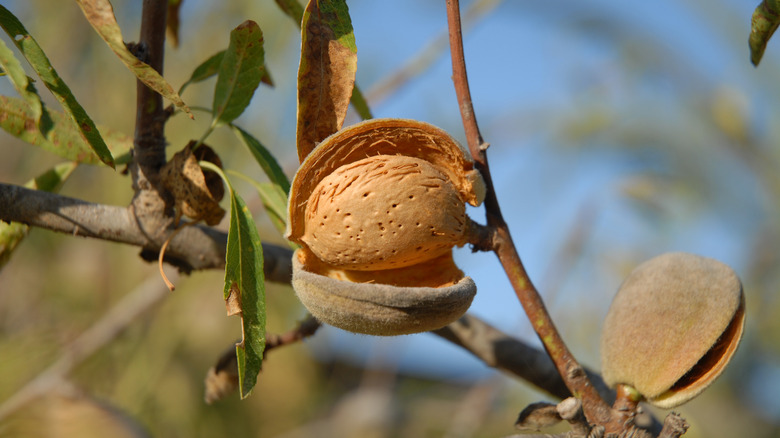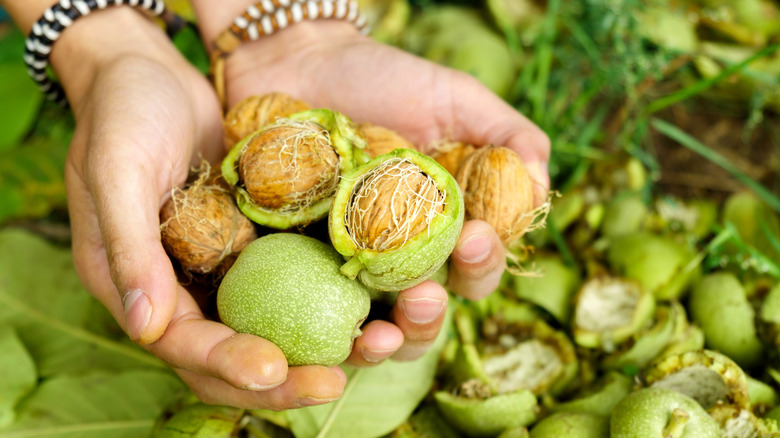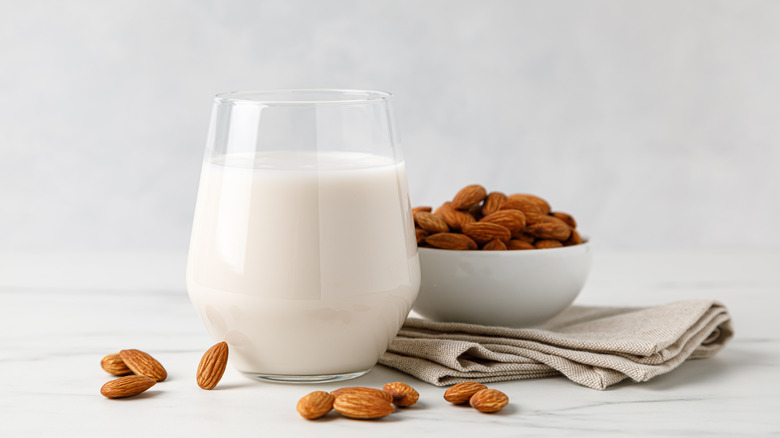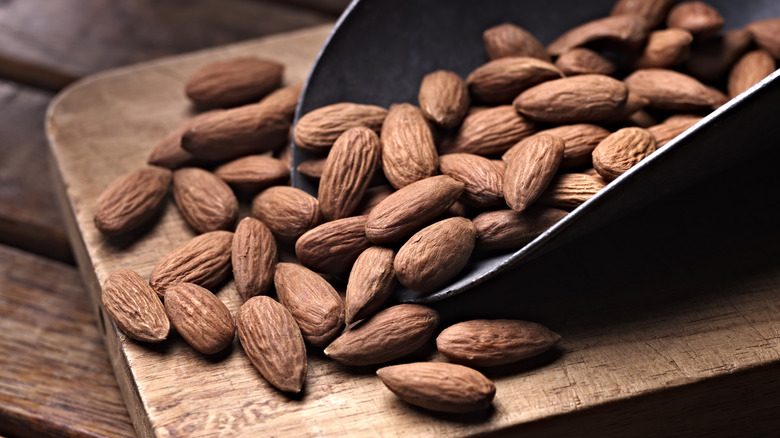Almonds Vs Walnuts: Everything You Need To Know
Nuts have a reputation for being one of the healthiest snacks out there. They are a rich source of protein and full of the kind of fats that are actually good for you, and they're so versatile that you can pretty much put them in anything. They make a filling and nutritionally balanced on-the-go snack, act as a delicious garnish on everything from salads to oatmeal, and can transform baked goods like bread and cookies. Adding to the versatility is the fact that each type of nut has its own flavor, texture, and nutritional profile. Two of the most popular are almonds and walnuts. Both are healthy and taste delicious in salads and trail mixes, but there many differences between them as well.
Almonds are known for their slightly sweet flavor and firm texture, and while they often crop up in recipes for desserts and salads, they have found even greater popularity as a milk alternative. Walnuts are more bitter in flavor and softer in texture and are predominantly used whole or chopped rather than turned into plant-based milks or flours. Keep reading to discover what makes almonds and walnuts different and how you can incorporate them into your diet in ways you might not have expected.
Almonds were first cultivated in 3000 B.C.
Almonds feature throughout history as a symbol of celebration and prosperity. They were first cultivated in the Mediterranean around 3,000 B.C. and became a staple of festive occasions. In Ancient Greece and Rome, newlyweds were showered with almonds or given them as gifts to symbolize fertility, happiness, and prosperity. The tree also thrived in parts of the Middle East, including Israel, where it came to symbolize the watchfulness and protection of God. The word for almond and the word for watching are even derived from the same root word. In the 18th century, Franciscan monks brought the tree to modern-day California, where it became one of the state's most lucrative crops.
Today, almonds are grown across the world in countries as far apart as the US, Spain, Australia, Morocco, and Turkey, among many others. Of these producers, the U.S. is by far the largest, growing more than two million tons. In a distant second place is Spain, which produces around 365,000 tons. California alone produces 80% of the world's supply.
Walnuts are the earliest cultivated tree food
Walnuts are even older than almonds, having been cultivated since at least 7,000 B.C. In some languages, the word for walnut and the word for nut are the same, pointing to their pedigree as the world's first cultivated tree food. In Greece, walnuts were used for making oil even before olives were, and in some parts of Russia and East Asia, walnut tree sap is used in the same way maple syrup is used in North America. In Ancient Rome and Persia, they were regarded as a food fit only for royalty.
Unlike almonds, whose trees are not widely used apart from their nuts, walnut trees are valued highly for their wood, which is dense and smooth. Because there are 22 species of walnut, the wood also comes in colors ranging from almost white to a rich, dark brown.
These days, walnuts are produced mainly in China, which grows about 1.4 million tons. The US is a distant second, producing about 682,000 tons, while Chile produces about 200,000. As this geographic spread suggests, walnuts are sturdy trees capable of thriving in various climates and can be found growing in the wild all over the world.
Almonds are full of healthy minerals and protein
You've probably heard that almonds are healthy, but let's break down exactly why they've earned that reputation. A one-ounce serving, which works out to about a quarter cup, contains 6 grams of protein and about 13% of the recommended daily value of fiber, per the FDA. It also provides nearly half of the recommended daily value of vitamin E, an antioxidant that bolsters the immune system and has been shown to help fight diseases such as cancer, cataracts, and Alzheimer's disease, according to a 2014 literature review in Sultan Qaboos University Medical Journal.
For those watching their caloric intake or trying to avoid fat, almonds may not seem like the best snacking option. A quarter-cup serving contains 164 calories and 14 grams of fat, but this should not deter anyone from making them a go-to snack. According to the Harvard T. H. Chan School of Public Health, almonds reduce the level of unhealthy cholesterol in the body, thereby lowering the risks of heart disease. On top of this, the fat in almonds is unsaturated but just as filling as any other type of fat, meaning that if you eat a quarter cup of almonds, you're less likely to reach for a snack that has the same amount of calories but contains saturated fats and fewer nutrients.
Walnuts are full of healthy fats
Walnuts are just as healthy as almonds, though, at first glance, they don't appear to stack up well. According to the FDA, a quarter cup of walnuts contains 185 calories and 19 grams of fat and provides only a fraction of the amount of vitamin E that a serving of almonds does. It also contains less fiber and protein. However, it does have some vitamin B6, which aids the immune system, brain health, and nervous system (per the Mayo Clinic), as well as phosphorus and manganese.
It's fitting that walnuts bear an uncanny visual resemblance to the brain, because one of their biggest health benefits is cognitive functioning. High levels of anti-inflammatory omega-3 fatty acids make walnuts a tool for delaying and even alleviating some of the most feared age-related diseases. According to a 2020 report in Nutrients that reviewed human and animal studies, incorporating walnuts into the diet can help reduce and even slow the progression of conditions like Alzheimer's disease, Parkinson's disease, strokes, and even depression. A study in the International Journal of Endocrinology and Metabolism from 2016 also found that consuming walnut oil can make people with type 2 diabetes less resistant and more sensitive to insulin due to its high concentration of polyunsaturated fatty acids.
Almonds are hard on the environment
The toll that almonds take on the environment has received an avalanche of press coverage in recent years. Sadly for those of us who love almond milk and enjoy putting almonds in almost every recipe, the nut requires a lot of water, which, in California, is often tough to come by.
Starting in the early 2010s, the state that produces 80% of the world's almond supply has experienced long, punishing droughts that severely tax its water supply. At the same time, demand for almonds has skyrocketed. They even overtook peanuts in 2014 to become the most-eaten nut in the US. In 2015, almond crops in California used more water in a single year than the entire city of Los Angeles did in three years. Around the same time, thousands of salmon were dying as the state diverted their river water supply to almond farms. Almond advocates downplay these environmental concerns, pointing to the water reduction efforts that California almond farmers have been pursuing, but there is no way around the fact that demand for the nut continues to grow and California, which is the only state that commercially produces them, continues to be plagued with severe droughts.
Walnuts are relatively sustainable
Walnuts also require water to grow, of course, and many estimates even suggest that they require more water than almonds. However, location is a major factor when it comes to the toll that water consumption takes. For example, Oregon experiences so much precipitation that hazelnut farms historically relied on natural rainfall and did not have to water the crops at all. According to an analysis from Citizens Sustainable that examined a roster of environmental factors such as water use, pesticide use, and carbon emissions from transportation, walnuts stacked up well compared to other nuts. Peanuts, hazelnuts, walnuts, and chestnuts were the most sustainable, while cashews, almonds, and pistachios ranked worst.
A comprehensive study from 2022 published in Sustainability Science examined the environmental, nutritional, and social attributes of nuts and seeds to determine which had the greatest benefits overall. It found that walnuts and sunflower seeds ranked highest overall. Despite these positive analyses, however, it's important to note they are location-dependent. Approximately 99% of the walnuts produced in the U.S. are grown in California, which, as we previously noted, is water-poor.
Almonds are turned into flour and milk alternatives
Almonds appear in trail mixes, granolas, and baked goods, but they have an outsized presence in the plant-based milk aisle. Almond milk is a booming industry. Sales reached $344 million in the U.S. alone in 2021, while the once-supreme soy milk only amassed $34 million. Even though plant-based milks might seem like a modern phenomenon, they have been around for over a thousand years. According to medical texts from the time, doctors used almond milk to treat coughing and shortness of breath way back in the 8th century, while Christians often used it in later periods as an alternative to dairy during Lent. Its recent spike in popularity is not expected to change, and many market projections expect it to continue rising in value.
Another popular almond-based product is almond flour, which is used as a substitute for grain-based flour. It is particularly popular for those following gluten-free and low-carb diets and it boasts a hefty dose of protein. If you've never tried baking with almond flour, our deliciously nutty recipe for gluten-free chocolate chip cookies is a great place to start.
Walnuts make versatile garnishes
Although you can make walnut milk at home in the same way you can make almond milk or oat milk, it is almost impossible to find at the grocery store. This likely has more to do with the whims of the market and nut milk manufacturers than it does with the quality of walnut milk, but there are plenty of other places you can find this delicious, healthy ingredient. In fact, you could argue that walnuts are even more versatile than almonds.
Due to their buttery texture, walnuts provide the perfect accent to baked goods, whether you're making classic banana bread or a delicious carrot cake. Where almonds can be overly crunchy and disrupt the soft texture of quick breads and cakes, walnuts offer just enough crunch to make the texture interesting, but not enough to clash with it. They also provide a subtle, nutty flavor that can be dialed up into something heavenly and aromatic when roasted.
Walnuts are just as delicious in savory dishes, both cooked and uncooked. Pairing apples and walnuts in a green salad is a classic combination for a reason, while adding the nut to a chicken or tuna salad can elevate the recipe by leaps and bounds. You can even use them instead of breadcrumbs for an extra-rich crunchy topping on fish.
Almonds are more popular globally
No offense to walnuts, but the numbers don't lie: almonds are more popular. In the U.S., they are the most consumed nut, while around the world, they take second place behind peanuts. Globally, 1.2 million tons of almonds were consumed in 2018, followed by 888,000 tons of walnuts and 792,000 tons of cashews. All of these are dwarfed, however, by the 42.6 million tons of peanuts that were consumed.
The popularity of almonds can be attributed in part to their use in plant-based products like milk, even though the amount of nuts that are actually used to make almond milk may be as low as 2% according to a class action lawsuit filed against the manufacturers of Almond Breeze. Their relatively high protein content and low fat content compared with other nuts also makes them popular. While the health benefits of nuts extend far beyond their calorie count and fat content, it's easier to compare these metrics on nutrition labels than it is to compare things like omega-3 fatty acids and antioxidants.
Walnuts may be more affordable
Nut prices are relative. The category is much pricier than other snacks, which makes them a luxury item for many consumers. But when comparing the cost of nuts, walnuts have a slight advantage over the competition. The USDA's inflation-adjusted report on 2022 prices of walnuts, almonds, and hazelnuts found that all three had fallen to the lowest prices they'd been in two decades. Of the three, however, walnuts were the cheapest, costing 25 cents per pound compared to 51 cents for hazelnuts and $1.10 for almonds.
It's worth noting that these figures reflect how much growers were paid for each type of nut, not how much consumers were paying for them. Depending on various factors such as the store you're going to, the brand you're purchasing, and whether or not you're purchasing in bulk, walnuts may not be cheaper than almonds. At the national market level, however, they are significantly more affordable, so keep your eyes peeled for good deals.
Almonds can either be sweet or bitter
Almonds are often described as having a sweet flavor, but there are two main types of almonds — sweet and bitter — and the latter bears no hint of sweetness. The reason almonds are usually associated with sweetness is because sweet almonds are the only ones sold as food. The bitter variety grows in the wild and contains enough cyanide to kill an adult. According to a study published in ISRN Toxicology, you are unlikely to die from eating bitter almonds unless you manage to ingest about 50 of them. Concerningly, however, it only takes 5-10 to kill a child. This is not a nut that's good for foraging.
Although they are not widely grown for culinary purposes, bitter almonds are cultivated for use in some edible products due to their intense flavor and aroma. Liquors and almond extracts are sometimes made with their oils, and in Tunisia, they are still used to make a popular syrup. For the most part, however, bitter almonds are used for inedible products such as skincare. Just make sure to check which type of almond you're looking at when you see an almond tree in the wild. It's not worth the consequences.
There are two main types of walnuts
There are about 20 species of walnut trees that fall under the Juglans genus, but English walnuts and Black walnuts are by far the most common. Despite their name, English walnuts are not from England. Known originally as Persian walnuts, they became associated with England in the 18th century when English merchants began distributing them more widely. Black walnuts are native to North America and were a staple in many Native American diets. They were used to make everything from beverages to bread and were a key medicinal ingredient for treating ailments including snakebites and smallpox. They also produce a brown pigment that was used to dye textiles and wood.
When people think of walnuts, they are probably imagining English walnuts, the crumbly, light-brown nut with a mild flavor and easily-cracked shell. English walnuts make up about 40% of the global walnut market and about 99% of the American market. Black walnuts have a stronger flavor and are less rich, containing 10% less fat overall and 20% less omega-3 fatty acids than English walnuts (per Tufts University). Their shells are also more difficult to crack, but if you find them in the wild, they are safe to eat. Unlike almonds, they make an excellent quarry for foraging.
Almonds can be stored for up to three years
When stored in a dry, airtight container, nuts will not get moldy like bread or condiments, but they will get stale and, eventually, become rancid. Stale nuts are not pleasant to eat, but they do not pose a health risk and will become crunchy and delicious again when roasted. Rancid nuts, on the other hand, are beyond salvation. Their sour flavor is an indication that the oil has started to spoil, and when this happens, there is no way to bring them back.
Luckily, almonds have a long shelf life, even compared to other types of nuts. The antioxidants that make them so healthy for us are also what provide their longevity. Store them in cool, dry, airtight conditions out of direct sunlight and they can last up to two years. Almonds that are stored in their shells can last for three years. Blanched almonds, as well as those that have been roasted with oil or sliced, will only last about 18 months.
Walnuts have a shorter shelf life
Due to their high oil content, walnuts do not last as long as almonds when kept in identical conditions. The more oil nuts they have, the more likely they are to grow rancid, especially when exposed to warmth, sunlight, or moisture. If you usually keep nuts in jars near your stove, you might want to consider moving them to a cupboard or pantry, since the warmth of the stove, ambient light, and even condensation from cooking can shorten their shelf life.
The shorter lifespan of walnuts is particularly inconvenient given that buying nuts in bulk is often the cheapest option. If you purchase a pound or more and are worried about them going rancid, the freezer will save the day. Shelled walnuts can stay frozen for up to a year without the hint of sourness. Leave the amount you'll need over the next few months in the pantry and set aside the rest for the freezer.














